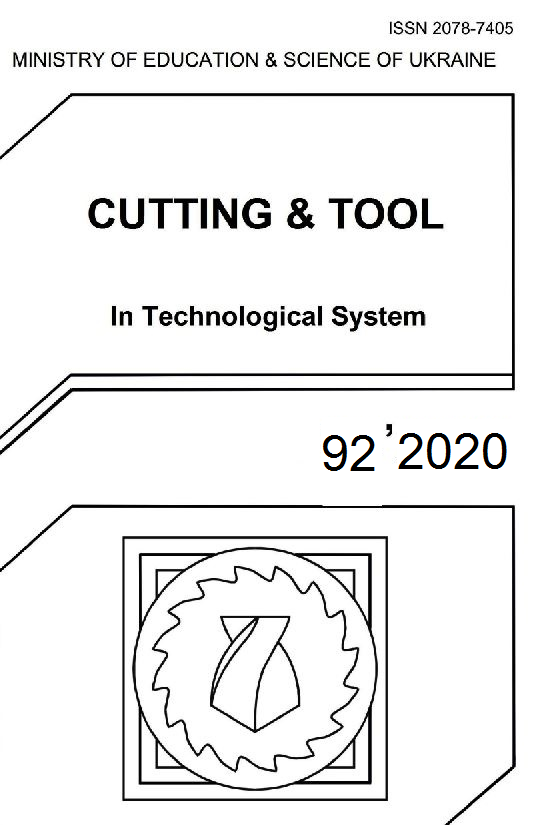INVESTIGATION OF SHAPE CORRECTNESS OF DIAMOND BURNISHED LOW ALLOYED ALUMINIUM COMPONENTS
DOI:
https://doi.org/10.20998/2078-7405.2020.92.19Keywords:
plastic deformation, burnishing, aluminum alloys, factorial experimental design method.Abstract
Conventional machining methods such as turning or milling can cause surface irregularities, defects such as tool traces and scratches, resulting in energy dissipation (friction) and surface damage (wear). In contrast, the environmentally friendly chipless burnishing process clearly improves the integrity of the machined surface and largely considered in industrial cases in order to restructure surface characteristics. In this paper influence of different burnishing parameters, such as burnishing speed (v), feed rate (f) and burnishing force (F) are examined. Based on theoretical considerations, we use full factorial experimental design method to determine the optimal combination level of the different parameters in the given interval. The measurement of the shape correctness was executed with Taylor Hobson Talyrond 365 measuring equipment at the Institute of Manufacturing Science.References
B. Karpuschewski, J. Kundrák, T. Emmer, D. Borysenko: A New Strategy in Face Milling - Inverse Cutting Technology, Solid State Phenomena, (2017) 261: 331-338.
J. Kundrák, C. Felhő: 3D Roughness Parameters of Surfaces Face Milled by Special Tools, Manufacturing Technology, 16, (2016) 532-538.
G. Varga, J. Kundrák: Effects of Technological Parameters on Surface Characteristics in Face Milling, Solid State Phenomena, 261, (2017) 285-292.
N.A. Chowdhury, A.U. Patwari, R.S. Mostafa: Development of a mathematical model for elastic field simulation during unloading condition in surface burnishing processes, Journal of Engineering, 2, (2008) 55-64.
T.C. Dyl: The burnishing process of the stainless steel in aspect of the reduction roughness and surface hardening, Journal of Kones and Transport, 24, (2017) 63-69.
S. Neagu-Ventzel, L. Luca, S. Cioc, M. Schuster, J. Pillar, I. Marinescu: FE 3D burnishing model, Precision Engineering, (2012) 1-8.
K. Konefal, M. Korzynski, Z. Byczkowska,
K. Korzynska: Improved corrosion resistance of stainless steel X6CrNiMoTi17-12-2 by slide diamond burnishing, Journal of Materials Processing Technology, 213, (2013) 1997-2004.
D.W. Lee, S.S. Cho: Comparison of X-ray residual stress measurements for rolled steels, International Journal of Precision Engineering and Manufacturing, 12, (2010) 1001-1008.
L. Fridrik: Chosen chapters from the topics of experimental design of production engineering, Műszaki Könyvkiadó, Budapest, 1987 (In Hungarian).
L. Bálint, L. Gribovszki: The basics of machine engineering technology, Miskolc, (1975) 418-442. (in Hungarian).
H. Tanaka, H. Tabuto, K. Yanagi: A metrological study on hardened steel surface finishing using a diamond burnishing tool, Proceeding of JSPE Spring Conference, 34, (2008) 1-4.
M. Jawahar, B. Shiva Kumarr, P. Vamshi Krishna: Experimental design an optimization of ball burnishing process for aluminium alloy 5083, International Research Journal of Automotive Technology, 5, (2018), 33-40.
Downloads
Published
Issue
Section
License
Copyright Notice
Authors who publish with this Collection agree to the following terms:
1. Authors retain copyright and grant the Collection right of first publication with the work simultaneously licensed under a Creative Commons Attribution License that allows others to share the work with an acknowledgement of the work's authorship and initial publication in this Collection.
2. Authors are able to enter into separate, additional contractual arrangements for the non-exclusive distribution of the Collection's published version of the work (e.g., post it to an institutional repository or publish it in a book), with an acknowledgement of its initial publication in this Collection.
3. Authors are permitted and encouraged to post their work online (e.g., in institutional repositories or on their website) prior to and during the submission process, as it can lead to productive exchanges, as well as earlier and greater citation of published work.

